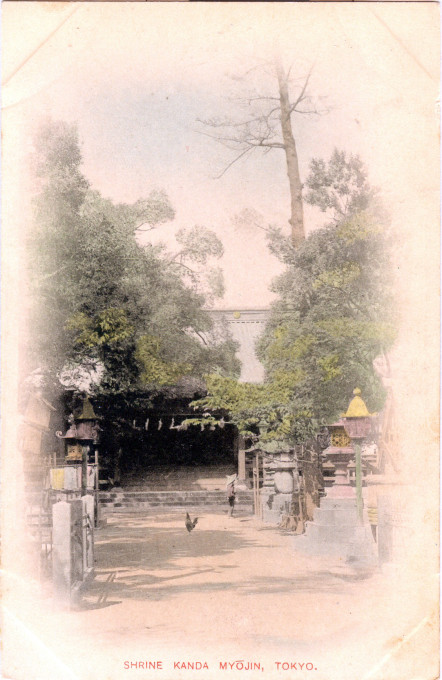“The Shinto temple of Kanda (commonly known as Kanda Mio-jin) stands in the Miyamoto-cho at the back of the Seido Public Library. The gods worshipped here are O-na-muchi (the aboriginal deity of the country, who is said to have resigned his throne in favour of the Mikado’s ancestors when they descended from heaven) and Sukuna-bikona, his adopted brother.
“The temple was founded in 730 on a site now inside the Kanda-bashi in honour of O-na-muchi alone. In the 13th century it was restored by Yii-gio Sho-nin, and the rebel Masnkado was joined with the other god as an object of worship. In 1603 it was removed to Suruga Dai, and 13 years later to its present site, then called Yu-shima, but retained its title of Kanda Mio-jin from its original site … The buildings have often been burnt down and rebuilt since 1606. The entrance is by two torii and a gate built in the style known as hafu-dzukuri, whose gray wood contrasts prettily with the fastenings in metal work.
“The temple is in the Rio-bu Shin-to style, of red painted wood, ornamented with gold; and though of late years all such Buddhist decorations as were moveable have been put out of sight, there still remain the panelling of the ceiling, the handsome carving of the screen which divides the oratory (hai-den) from the ante-chamber (nuka no ma), and the paintings round the walls of the latter by Kano Yoshi-nobu. The altar sparkles with gold, and the ceiling above it is decorated with dragons from the hand of Kano Ei-sen.”
– A Handbook for Travellers in Central & North Japan, by Ernest Mason Satow & Lieutenant A.G.S. Hawes, 1881
From the wiki: “Kanda Shrine [Kanda-myōjin] is a Shinto shrine located in Kanda, Tokyo. The shrine dates back 1,270 years, but the current structure was rebuilt several times due to fire and earthquakes. Kanda Shrine was an important shrine to both the warrior class and citizens of Japan, especially during the Edo period, when the first Tokugawa shogun, Ieyasu, paid his respects at Kanda Shrine.
“Kanda Shrine was first built in the second year of the Tenpyō Era (730 AD), in the fishing village of Shibasaki, near the modern Ōtemachi district. In order to accommodate the expansion of Edo Castle, the shrine was later moved to the former Kanda ward in 1603, then moved once again to its modern site on a small hill near Akihabara in 1616.
“The three major kami enshrined are Daikokuten, Ebisu, and Taira no Masakado. As Daikokuten and Ebisu both belong to the Seven Gods of Fortune, Kanda Shrine is a popular place for businessmen and entrepreneurs to pray for wealth and prosperity.
“Taira no Masakado, however, was a samurai who rebelled against the Heian government, and was later elevated to the status of kami out of reverence. He is an important figure in the shrine’s history. After his death in 940, his head was separated from his body and delivered to the Shibaraki area, near the shrine’s location today. Locals who respected his defiance enshrined him in Kanda Shrine, and his spirit is said to watch over the surrounding areas. It was rumored that when his shrine fell into disrepair, Masakado’s angry spirit wrought natural disasters and plagues upon the nearby lands. It is also said that shogun Tokugawa Ieyasu felt uncomfortable to have his castle built close to such a powerful spirit, and so decided to move Kanda Shrine to its modern location.
“During the Meiji period (1868-1912), the emperor was faced with public pressure to include Kanda Shrine in the Tokyo Ten Shrines, but hesitated to do so because of the shrine’s association with Masakado, who was seen as an anti-government figure. This was temporarily resolved by removing Taira no Masakado as an enshrined kami. However, Masakado’s spirit proved so popular amongst the commoners, that it was symbolically returned to the shrine after WWII.”


